
Food Safety Focus (7th Issue, February 2007) – Food Safety Platform
Colouring Matter in Food
Reported by Miss Joan YAU, Scientific Officer,
Risk Assessment Section, Centre for Food Safety
Year of the Pig has come! Gold and red are the favourite colours in this festive season because they mean fortune and luck. "Golden" Chinese New Year pudding (with golden leaves added for decoration) and "red" fried dumplings are therefore popular food items that people in Hong Kong would like to buy.
Illustration: Red fried dumpling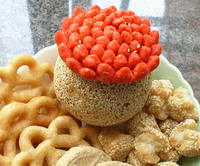
Besides the Chinese, many different cultures around the world recognise that people "eat with their eyes" and have special emphasis on colour of the food. The art of making coloured candies has been described in the wall painting in the Egyptian tombs. Long time ago, people have started to use saffron (spices derived from dried aromatic stigmas of the Crocus sativus flower) and other spices to provide a yellow colour to food. Butter has also been coloured yellow since 1300s.
Illustration: Butter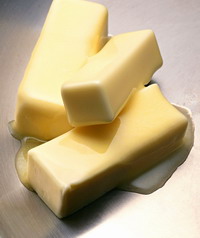
What is Colouring Matter?
Colouring matter refers to substance, either natural or synthetic, which adds or restores colour in food. Edible fruits and vegetables are the major sources of natural colours. Certain food colours (e.g. carotenes) can be obtained both naturally and synthetically. Nowadays, there are more than 50 types of colouring matter available for food use.
Natural colour in food may be lost through exposure to light, air, extremes of temperature and moisture. Different processing conditions may also contribute to colour fading. The added colouring matter (e.g. beta-carotene in juice drinks) may offset the resulting colour loss. It can also help maintaining the colour uniformity among different batches of the same food product.
Certain colours nowadays provide distinctive characteristics to particular food items, e.g. caramel coloured cola drinks and purple taro-flavoured ice-cream. Last but not least, colouring matter makes special treats and fun foods (e.g. candies, cakes, etc) more attractive. With the addition of colouring matter, a wide variety of food can be provided to fulfill our cultural needs and enhance our enjoyment of food.
Illustration: Jelly beans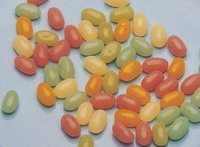
Is Colouring Matter Safe for Consumption?
Similar to other food additives, colouring matter is subject to safety evaluation by the international food safety authority, the Joint Food and Agriculture Organization / World Health Organization Expert Committee on Food Additives. Usually a small amount of added colour is sufficient to achieve the desired colour. Both natural and synthetic colouring matter can therefore be safely consumed so long as they are properly applied to food in accordance with good manufacturing practice. Details regarding the safety of food additives are available in previous issue.
How is Colouring Matter Regulated in Hong Kong?
The Colouring Matter in Food Regulations (Cap. 132H) stipulate which colouring matter is permitted for food use. In addition, no colouring matter is permitted to be added to meat, game, poultry, fish, fruit or vegetable in a raw and unprocessed state.
Starting from July 2007, the presence of food additives including colouring matter in prepackaged food available in Hong Kong must be listed by their functional classes and specific names or identification numbers under the International Numbering System for Food Additives with or without the prefix "E" or "e" on the food label.
Can I Know Whether a Food Colour is Naturally Occurring?
It is difficult to distinguish the same colour derived from natural or synthetic source.
There have been complaints or media reports about the abuse of colouring matter in food. The CFS has from time to time identified these irregularities such as the abuse of sunset yellow FCF and tartrazine in yellow croaker, orange II in Chinese pudding as well as Sudan colours in chilli powder.
The CFS has also received complaints about "non-permitted" colours exuded from black rice or purple sweet potatoes during washing or cooking. After investigation, these foodstuffs were found to contain naturally occurring colours and there was no evidence that colours had been intentionally added. In fact, it is a normal phenomenon that colours naturally present in fruits and vegetables (e.g. anthocyanins in black rice, sweet potatoes and red cabbages; lycopenes in tomatoes; and carotenes in carrots) will exude during food preparation. There is no need for undue concern.
Illustration: Colour exuded from black rice soaking in water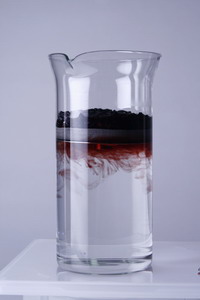
Illustration: Food plants containing natural colours (left to right): red cabbage, tomato and carrot
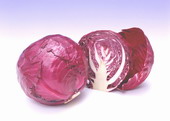


The public are advised to avoid food with abnormally intense colour or sold at an excessively low price. They should check if the food colour remains abnormally brilliant when cooking and do not buy or consume any food when in doubt. Retailers should not sell fresh food suspected to have colour added.


